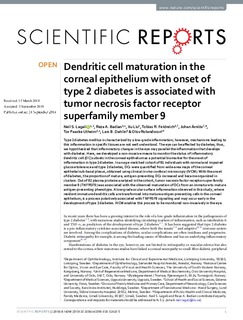| dc.contributor.author | Lagali, Neil | |
| dc.contributor.author | Badian, Reza | |
| dc.contributor.author | Liu, Xu | |
| dc.contributor.author | Feldreich, Tobias R. | |
| dc.contributor.author | Ärnlöv, Johan | |
| dc.contributor.author | Utheim, Tor Paaske | |
| dc.contributor.author | Dahlin, Lars B. | |
| dc.contributor.author | Rolandsson, Olov | |
| dc.date.accessioned | 2018-10-26T07:41:29Z | |
| dc.date.available | 2018-10-26T07:41:29Z | |
| dc.date.created | 2018-10-21T15:33:39Z | |
| dc.date.issued | 2018 | |
| dc.identifier.citation | Scientific Reports. 2018, 8:14248, 1-10. | nb_NO |
| dc.identifier.issn | 2045-2322 | |
| dc.identifier.uri | http://hdl.handle.net/11250/2569705 | |
| dc.description | Open Access This article is licensed under a Creative Commons Attribution 4.0 International License, which permits use, sharing, adaptation, distribution and reproduction in any medium or format, as long as you give appropriate credit to the original author(s) and the source, provide a link to the Creative Commons license, and indicate if changes were made. The images or other third party material in this article are included in the article’s Creative Commons license, unless indicated otherwise in a credit line to the material. If material is not included in the article’s Creative Commons license and your intended use is not permitted by statutory regulation or exceeds the permitted use, you will need to obtain permission directly from the copyright holder. | nb_NO |
| dc.description.abstract | Type 2 diabetes mellitus is characterized by a low-grade inflammation; however, mechanisms leading to this inflammation in specific tissues are not well understood. The eye can be affected by diabetes; thus, we hypothesized that inflammatory changes in the eye may parallel the inflammation that develops with diabetes. Here, we developed a non-invasive means to monitor the status of inflammatory dendritic cell (DC) subsets in the corneal epithelium as a potential biomarker for the onset of inflammation in type 2 diabetes. In an age-matched cohort of 81 individuals with normal and impaired glucose tolerance and type 2 diabetes, DCs were quantified from wide-area maps of the corneal epithelial sub-basal plexus, obtained using clinical in vivo confocal microscopy (IVCM). With the onset of diabetes, the proportion of mature, antigen-presenting DCs increased and became organized in clusters. Out of 92 plasma proteins analysed in the cohort, tumor necrosis factor receptor super family member 9 (TNFRSF9) was associated with the observed maturation of DCs from an immature to mature antigen-presenting phenotype. A low-grade ocular surface inflammation observed in this study, where resident immature dendritic cells are transformed into mature antigen-presenting cells in the corneal epithelium, is a process putatively associated with TNFRSF9 signalling and may occur early in the development of type 2 diabetes. IVCM enables this process to be monitored non-invasively in the eye. | nb_NO |
| dc.language.iso | eng | nb_NO |
| dc.rights | Navngivelse 4.0 Internasjonal | * |
| dc.rights.uri | http://creativecommons.org/licenses/by/4.0/deed.no | * |
| dc.title | Dendritic cell maturation in the corneal epithelium with onset of type 2 diabetes is associated with tumor necrosis factor receptor superfamily member 9 | nb_NO |
| dc.title.alternative | Dendritic cell maturation in the corneal epithelium with onset of type 2 diabetes is associated with tumor necrosis factor receptor superfamily member 9 | nb_NO |
| dc.type | Journal article | nb_NO |
| dc.type | Peer reviewed | nb_NO |
| dc.description.version | publishedVersion | nb_NO |
| dc.rights.holder | © The Author(s) 2018 | nb_NO |
| dc.source.pagenumber | 1-10 | nb_NO |
| dc.source.volume | 8:14248 | nb_NO |
| dc.source.journal | Scientific Reports | nb_NO |
| dc.identifier.doi | 10.1038/s41598-018-32410-5 | |
| dc.identifier.cristin | 1622005 | |
| cristin.unitcode | 222,56,2,0 | |
| cristin.unitname | Institutt for optometri, radiografi og lysdesign | |
| cristin.ispublished | true | |
| cristin.fulltext | original | |
| cristin.qualitycode | 1 | |

